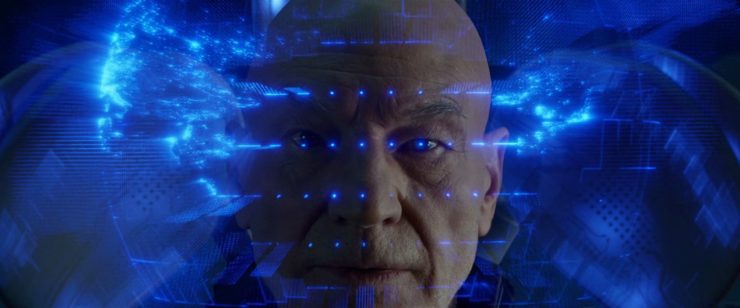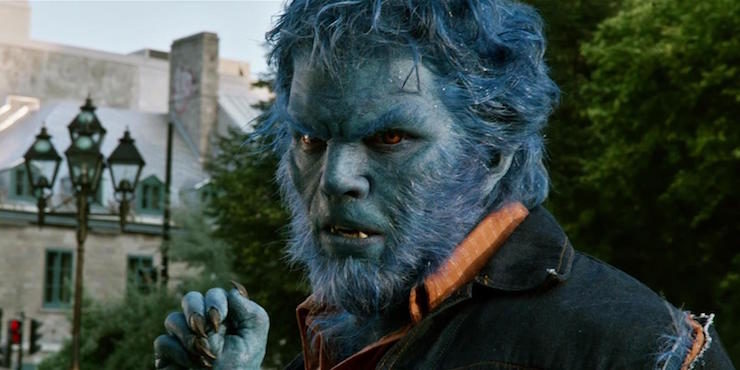One of the best, and most influential, stories in the entire history of X-Men comics was the two-part “Days of Future Past” storyline in Uncanny X-Men #141-142 in 1981 by Chris Claremont and John Byrne. It was the pair’s swan song as collaborators, as Byrne left the title one issue later, ending one of the most impressive runs on any superhero comic.
The story—which had the X-Men from a dystopian future sending one of their own into the past to try to change history—would prove hugely influential. The characters of Cable, Bishop, Rachel Summers, Nimrod, Fitzroy, and Stryfe, among others, came from that alternate future, and the comics did many sequels.
It was also the subject of the movie that served as a sequel to both First Class and The Last Stand.
With now, in essence, two sets of X-Men, it made sense to adapt one of the best-known X-stories to use both. They also jumped the timeline of each a decade. The younger versions moved from 1962 to 1973, while the older ones went from 2013 (when we last saw Logan, Xavier, and Magneto in The Wolverine) to 2023. (Ironically, the original story from 1981 had the future segments take place in 2013, which seemed unimaginably far in the future then.)
Both stories posit a dystopian future where Sentinels—giant mutant-hunting robots, first introduced way back in Uncanny X-Men #14 in 1965—all but rule the world. (In the comics, they control the U.S., in the movie they’re much more ubiquitous.) A character is sent back in time to inhabit the body of their younger self to convince the X-Men to stop an assassination committed by Mystique. In the comics, it was a senator and presidential candidate, Robert Kelly, a very anti-mutant politician, but his death sets a series of events into motion that makes the anti-mutant sentiment in America worse. In the film, it’s Bolivar Trask, the creator of the Sentinels, but Mystique’s subsequent capture after killing him leads to the Sentinels being remodeled based on her changeable physical structure, allowing the Sentinels to physically adapt to any attack.
Buy the Book
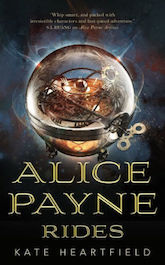

Alice Payne Rides
While Mystique being the focal point remains the same, it’s Wolverine rather than Kitty Pryde who’s sent to the past, as he’s the breakout character in the film franchise. For some reason, they have Pryde instead be the one to send him back, even though it’s a power she only has in this movie (and which bears no relation to her actual phasing powers). The movie also has our heroes changing history in 1973, so everything that happened in the five previous films that took place after ’73 has been changed. (In the case of X-Men Origins: Wolverine and especially The Last Stand, I think we’re all okay with that.)
Originally, Matthew Vaughn was to return to direct this, and he and his writing partner Jane Goldman wrote a treatment for the film, but he decided to go off and do Kingsman: The Secret Service instead, so they brought Bryan Singer back to direct for the first time since X2.
Back from First Class are James McAvoy as young Xavier, Michael Fassbender as young Magneto, Jennifer Lawrence as Mystique, Nicholas Hoult as young McCoy, and Lucas Till as Havok. Back from The Last Stand are Hugh Jackman as Wolverine, Sir Patrick Stewart as old Xavier, Sir Ian McKellen as old Magneto, Kelsey Grammar as old McCoy, Halle Berry as Storm (her role was reduced from what was scripted due to Berry being pregnant at the time of filming), James Marsden as Cyclops, Famke Janssen as Jean Grey, Ellen Page as Pryde, Daniel Cudmore as Colossus, Shawn Ashmore as Iceman, and Anna Paquin as Rogue. (Paquin’s role in the final film is a brief cameo; originally there was an entire subplot involving her, but it wasn’t working out, so it was cut. There is a “Rogue Cut” of the film that restores her subplot.) Newly arrived in this film are Peter Dinklage as Trask, Josh Helman as a young William Stryker (previously played by Danny Huston in X-Men Origins: Wolverine, and as an older man by Brian Cox in X2), Omar Sy as Bishop, Evan Peters as Quicksilver, Fan Bingbing as Blink, Adan Canto as Sunspot, Booboo Stewart as Warpath, Evan Jonigkeit as a young Toad (the older version previously played by Ray Park in X-Men), Gregg Lowe as Ink, Michael Lerner as a senator, and Mark Camacho as President Richard Nixon.
McAvoy, Fassbender, Lawrence, Hoult, Peters, Till, Helman, and Jackman will all next be seen in Apocalypse. Stewart will next appear in Logan.
“I’ve been in a lot of wars, I’ve never seen anything like this”
X-Men: Days of Future Past
Written by Jane Goldman & Matthew Vaughn and Simon Kinberg
Directed by Bryan Singer
Produced by Lauren Shuler Donner and Bryan Singer and Simon Kinberg and Hutch Parker
Original release date: May 23, 2014
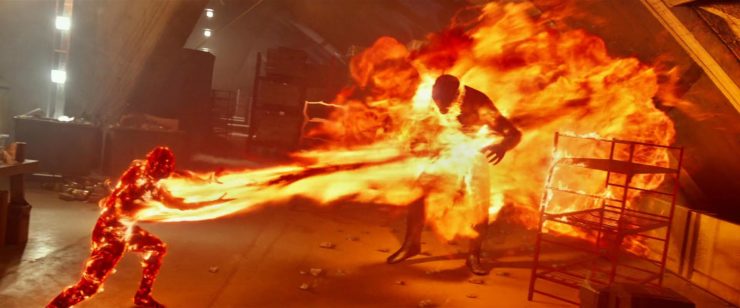
In 2023, Sentinels, robots that can adapt and change shape, have all but taken over the world. The Sentinels have divided humanity into three categories: humans, humans with the potential to birth mutants, and mutants. The latter are pariahs, hunted down. The remnants of the X-Men—Charles Xavier, Magneto, Storm, Wolverine, Iceman, Colossus, and Kitty Pryde, as well as newcomers Bishop, Blink, Warpath, and Sunspot are on the run. Pryde is able to send someone’s consciousness back in time to an earlier version of themselves, and they have been able to stay ahead of the Sentinels by having Pryde send Bishop back in time a few hours so they aren’t where the Sentinels find them.
Xavier proposes that Pryde send him back in time to 1973 so he can change the tipping point in history: Mystique’s assassination of Bolivar Trask, creator of the Sentinels. The government captured Mystique after she killed Trask and used her DNA as the basis for the Sentinels’ adaptive capabilities.
Unfortunately, Pryde can’t send someone back fifty years without doing incalculable damage to their minds. However, Wolverine volunteers, counting on his healing factor to keep his mind safe. Xavier and Magneto warn that neither of them will be easy to convince: At this stage, Xavier was taking medication to allow him to walk, which also suppressed his telepathy, and Magneto was imprisoned under the Pentagon, accused of killing President John F. Kennedy. (He didn’t—he tried to save him and failed.)
Logan shows up in 1973, in bed with a woman his younger self is supposed to be protecting. He extricates himself from that situation and heads to Westchester, only to find that the School for Gifted Youngsters is shut down, with only Xavier and Hank McCoy present. Most of his students were drafted for the Vietnam War, and Xavier has fallen into despair. Wolverine convinces him that he really has come from the future, and plays on his affection for Mystique to get him to agree to stop her.
For her part, Mystique has gone to Vietnam to save a platoon of mutants—Havok, the Toad, and Ink—from being taken away by Major William Stryker.
Trask testifies before Congress, including two congresspeople who look just like Chris Claremont and Len Wein, proposing mutant-hunting robots called Sentinels. Congress rejects the notion.
With the help of Peter Maximoff, a mutant with super-speed, Wolverine (who will meet Maximoff in the future, which is why he knew to recruit him), Xavier, and McCoy break Magneto out of his concrete prison.
Mystique travels to Paris to kill Trask at the Paris Peace Accords that ends the Vietnam War. Xavier, Magneto, McCoy, and Wolverine try to stop her—but Magneto takes matters into his own hands by trying to kill Mystique. McCoy fights Magneto to stop him and save Mystique, and in the end they’re all publicly exposed as mutants. This assassination attempt convinces President Nixon to approve Trask’s Sentinel program (just as his actual assassination did in the original timeline).
Magneto and Mystique both go off on their own. Wolverine and McCoy take Xavier back to the X-mansion, where Xavier needs a dose of his medication—but Wolverine convinces him not to take it, but rather to use his telepathy once again. He mind-links with Wolverine, and through him with his future self, where the older, sadder Xavier convinces his younger, more depressed self of the importance of the mission.
Using Cerebro for the first time in a while, Xavier tracks Mystique to Washington, D.C., where Trask plans to unleash his Sentinel prototypes on the White House lawn. However, Magneto—who has retrieved his helmet from the Pentagon, thus keeping him immune to Xavier’s telepathy—has secretly taken control of the prototypes. He lifts the outer structure of RFK Stadium and uses it to enclose the White House even as he takes control of the Sentinels.
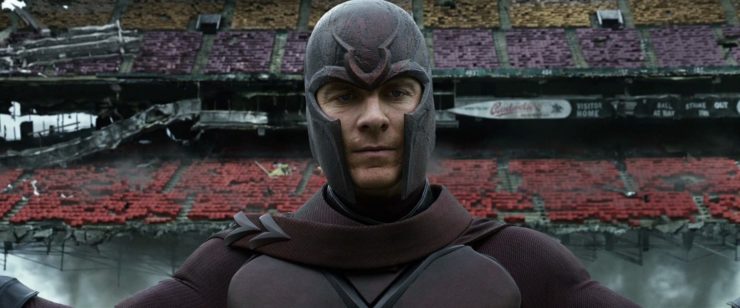
Mystique, meanwhile, has changed shape to that of a Secret Service agent, and tries to assassinate Trask, but Xavier is able to stop her. Chaos ensues, exacerbated by Magneto’s arrival with a stadium, and Nixon, Trask, and several other staffers go into the bunker under the White House. Unfortunately, the bunker is made of metal, so Magneto is able to extract it from underground and bring it out.
Even as this is going on, in 2023 the Sentinels have found the X-Men. They need to delay the Sentinels long enough for Wolverine to change history, which he hasn’t done yet. One by one, the Sentinels kill each of them, leaving only Xavier, Pryde, and Wolverine.
Mystique manages to stop Magneto from killing Nixon, but she still wants to kill Trask. Xavier convinces her not to, as she’s just set herself up as the hero who saved the president. Sure enough, after Mystique drops her weapon, history changes.
Wolverine returns to 2023 only to find that a lot has changed: Scott Summers and Jean Grey are still alive, the school is going great guns, and the Sentinels are nowhere to be found. Xavier—the only other person who knows anything about the previous timeline thanks to his mindlink with Wolverine and his future self—fills Logan in on what’s happened in the world since 1973.
In 1973, Mystique is indeed hailed as a hero, and Trask is arrested for selling secrets to the Vietnamese.
The final, post-credits scene sees a bunch of people in ancient Egypt chanting “En Sabah Nur,” a blue-skinned gentleman who telekinetically elevates stones.
“Too late, assholes!”
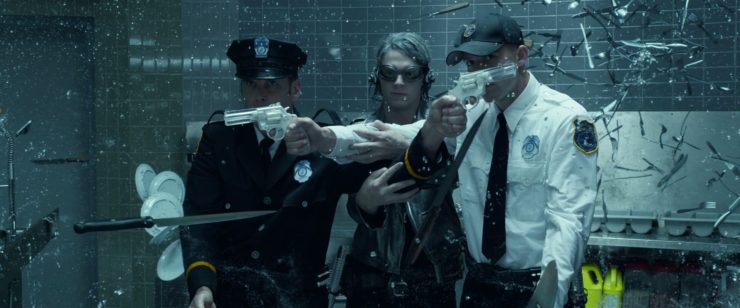
The original comics story that this movie is based on is one of the reasons why Uncanny X-Men was the most popular comic book on the planet throughout the latter part of the 1970s and into the early 1980s. It’s a beautifully done story, one that combines a science fiction dystopia with a strong introduction to a new Brotherhood of Evil Mutants. It also starkly shows a particularly nasty outcome of hatred against mutants—the same one Nazi Germany used, only with better technology.
None of the attempted followups really did justice to the original and that, unfortunately, includes this movie. Mind you, it’s not a bad movie. It’s enjoyable to see the two iterations of the X-franchise together in the same film, though there is, as usual, not enough of Patrick Stewart and Ian McKellen—though what we do get is fantastic. As good as James McAvoy and Michael Fassbender are, they can’t hold a candle to the overwhelmingly brilliant double act of Stewart and McKellen, and this movie shines a bit of a light on that, though it tries to dim that light by giving McAvoy and Fassbender considerably more screen time. Unfortunately, the one scene that I was originally most looking forward to when this movie was first announced turned out to be disappointing, when young Xavier talks to old Xavier, and Stewart pretty much acts McAvoy off the screen. (McAvoy isn’t aided by the script needing him to be rock-bottom at that point, so it’s mostly Stewart being inspirational—which, luckily, the latter is very good at.)
Some of the problems with First Class are present here as well, particularly with regard to cast bloat. There isn’t enough space to give everyone equal time, so where the secondary Hellfire Club bad guys are ciphers in First Class, it’s the extra X-Men in the future who get to be that in Days. Heck, even Storm barely has anything to do (though that was partly dictated by Halle Berry’s pregnancy). Blink, Bishop, Iceman, Pryde, Colossus, Sunspot, and Warpath barely even register as people.
The treatment of the characters from the last film is also a bit disappointing. Frost, Banshee, Azazel, and Salvadore are briefly mentioned by Magneto as having been killed, and that’s it. Havok shows up for half a second in Vietnam, a pointless cameo, and there isn’t even any mention of Riptide. Instead, we get Quicksilver (who never uses that name, sticking with Peter Maximoff), who’s actually a lot of fun as played with a delightfully laconic affect by Evan Peters, and McCoy, who has none of the comics character’s verve and wonderful mix of genius and wit. As with Xavier and Magneto, so too with the Beast—Nicholas Hoult is a decent enough actor, but he can’t hold a candle to Kelsey Grammar. (And we’re reminded of how much better he was in the part in his brief cameo at the end.)
Singer does a much better job of showcasing the era than Matthew Vaughn did, as I actually felt like I was watching something that took place in 1973: the fashions, the hairstyles, even the air quality all looked right. (I loved Logan waking up in a waterbed.) Peter Dinklage is his usual brilliant self as Trask, and I only wish they’d given him more screen time than Mark Camacho, who’s only about one step above Rich Little or Dan Aykroyd doing a Nixon impersonation rather than actually acting as Nixon. It’s a weak performance in a movie that has very few of those.
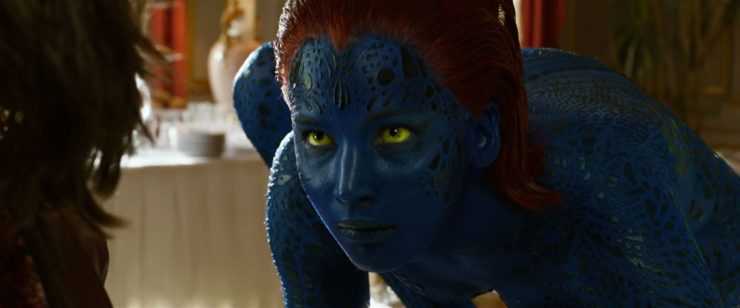
But the real star of this film is Jennifer Lawrence. Between these two X-films, Lawrence became a bona fide movie star thanks to her playing another literary figure, Katniss Everdeen. How much of Mystique’s beefed-up role was due to that, how much was due to Lawrence’s general awesomeness, and how much due to Mystique also being central to the original comics story is anybody’s guess, but the results here are worth it. Mystique’s bitterness at the top of the film, and the ruthless efficiency that we also saw in Rebecca Romijn’s older version in the first three films is on full display here. But her change of heart at the end is earned and convincing.
Fassbender continues to play Magneto as tormented. By the time of the first three films when he’s played by McKellen, Magneto is quite comfortable in his role as a super-villain, but here we see the other two ends of it. Fassbender’s Magneto is still angry and unfocused (and has also mostly been in jail since last we saw him), while McKellen’s older, more tired Magneto has found himself once again under the heel of fascists, only this time they’re robotic fascists.
Once again, Xavier, Magneto, and Mystique have to go through significant changes, though it’s interesting that Mystique’s is a reversal of what she went through in First Class.
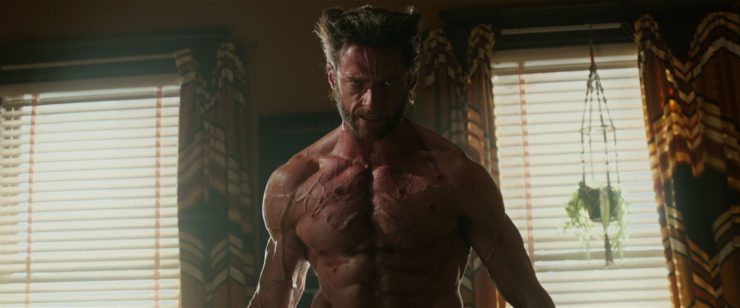
I haven’t mentioned Hugh Jackman, and it’s funny that they went to the trouble of making him the focus of the story rather than Kitty Pryde, but Wolverine himself is really just a plot device here. He doesn’t really do much beyond catalyzing the plot, and his being tossed aside into the Potomac by Magneto takes him out of much of the climax, and he isn’t really missed, either. It’s the first of Jackman’s starring roles as Wolverine (not counting his cameos in First Class and Apocalypse) in which he isn’t the center of attention. And honestly, that’s okay. One of the problems with the first three X-films is that they were the Wolverine and Friends show too often, to the detriment of the rest of the cast. It’s good to see a movie where Wolverine is actually a supporting character (in the literal sense) for a change.
The movie can’t hold a candle to its source material, but it’s a fun adventure movie that enables the producers to move forward unfettered by past continuity—the events of the movie basically change all history so that everything that happened in X-Men, X2, The Last Stand, X-Men Origins: Wolverine, The Wolverine, and the future portions of this film has been negated. (This will enable the upcoming Dark Phoenix to try to do the story better the second time.) It may be throwing the baby out with the bathwater—X-Men, X2, and The Wolverine are actually good movies—but at this point, it’s probably best to clean the slate, as it were.
Next week, we jump into the 1980s, as the X-Men take on Apocalypse.
Keith R.A. DeCandido has three new novels coming out in 2019: Alien: Isolation, based on the hit videogame from 2014 that also will feature lots of Ripley family backstory; Mermaid Precinct, the fifth novel in his series of fantasy police procedurals; and A Furnace Sealed, first in a new urban fantasy series about a nice Jewish boy from the Bronx who hunts monsters.










